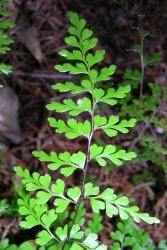Terrestrial (NZ) or epiphytic (not NZ) ferns. Rhizomes short- to long-creeping, scaly. Rhizome scales non-clathrate, narrowly ovate or trichome-like. Fronds monomorphic or dimorphic. Stipes red- or purple-brown, glabrous. Laminae 1-pinnate to 3-pinnate-pinnatifid (NZ), or rarely undivided or more than 3-pinnate-pinnatifid (not NZ), herbaceous or coriaceous, glabrous or with scattered hairs. Veins free (NZ) or reticulate (not NZ). Sori oblong or extending laterally or almost continuous around the lamina margin, superficial, marginal or submarginal; paraphyses present. Indusia present, attached at base and sometimes at the sides, opening towards the lamina margin. Spores monolete or trilete, perispores smooth or granulate.
The genus Lindsaea in Australia and New Zealand was revised by Kramer & Tindale (1976), who recognised 14 species in the region, of which three, L. linearis, L. trichomanoides and L. viridis, occurred in New Zealand. They assigned the Australasian species to two subgenera and six sections, but the molecular analyses of Lehtonen et al. (2010) subsequently showed that these groups were not monophyletic. Instead, Lehtonen et al. (2010) identified 13 clades within Lindsaea.
Lindsaea viridis belongs to clade II, along with species previously included in sections Isoloma and Sambirania by Kramer (1967, 1972). The clade extends from Madagascar, through Malesia and western Polynesia, to New Zealand. The sequences in this clade were found to be very divergent, suggesting that the extant species separated a long time ago. A base chromosome number for L. viridis of x = 44 has been recorded (Brownlie 1961).
Lindsaea linearis belongs to clade VII along with L. microphylla Sw., and probably also L. dimorpha F.M.Bailey (although the latter species was not sequenced). This is an Australian clade, extending to New Caledonia and New Zealand. The species are dimorphic and cytologically distinct, with n = 34 recorded from L. linearis in New Zealand (Brownlie 1958).
Lindsaea trichomanoides belongs to Clade X together with three New Caledonian species, L. rufa K.U.Kramer, L. nervosa Mett. and L. prolongata E.Fourn. The clade is biogeographically well-defined, being confined to eastern Australia, Tasmania, New Caledonia and New Zealand. Chromosome numbers of n = 40 and n = 42 have been recorded for L. trichomanoides (Brownlie 1957, 1965).
| 1 | Laminae linear, 1-pinnate; fertile and sterile fronds dimorphic; primary pinnae flabellate; indusia strongly toothed | linearis |
| Laminae narrowly elliptic, elliptic, narrowly ovate or ovate, 1–3-pinnnate-pinnatifid; fronds not dimorphic; primary pinnae ovate or narrowly ovate; indusia entire or only shallowly lobed or toothed | 2 | |
| 2 | Primary pinnae arising at wide angle to rachis; ultimate lamina segments ovate to obovate, apices obtuse or rounded; indusia elongated, curved around the lamina margin | trichomanoides |
| Primary pinnae arising at narrow angle to rachis; ultimate lamina segments narrowly obovate, apices truncate; indusia oblong or slightly extended along the lamina margin, straight | viridis |
In New Zealand, species of Lindsaea can be distinguished from the related Odontosoria by their red-brown stipes, 1–3-pinnate laminae, and sori that often extend laterally around the lamina margins. Odontosoria has pale brown stipes, 2–4-pinnate laminae, and sori that are usually oblong.
A pantropical genus of c.150 species extending into temperate regions of Japan, Australia and New Zealand (Lehtonen et al. 2010); the greatest diversity is in the Old World tropics with 19 species in Madagascar and the Indian Ocean (Roux 2009), 62 in Malesia (Kramer 1971), 15 in Australia (Kramer & McCarthy 1998) and perhaps 25 in the Pacific. Three species in New Zealand; one endemic.
| Category | Number |
|---|---|
| Indigenous (Endemic) | 1 |
| Indigenous (Non-endemic) | 2 |
| Total | 3 |
A wide range of base chromosome numbers have been reported in Lindsaea, including x = 34, 40, 42, 44, 47 and 50 (Lehtonen et al. 2010).




